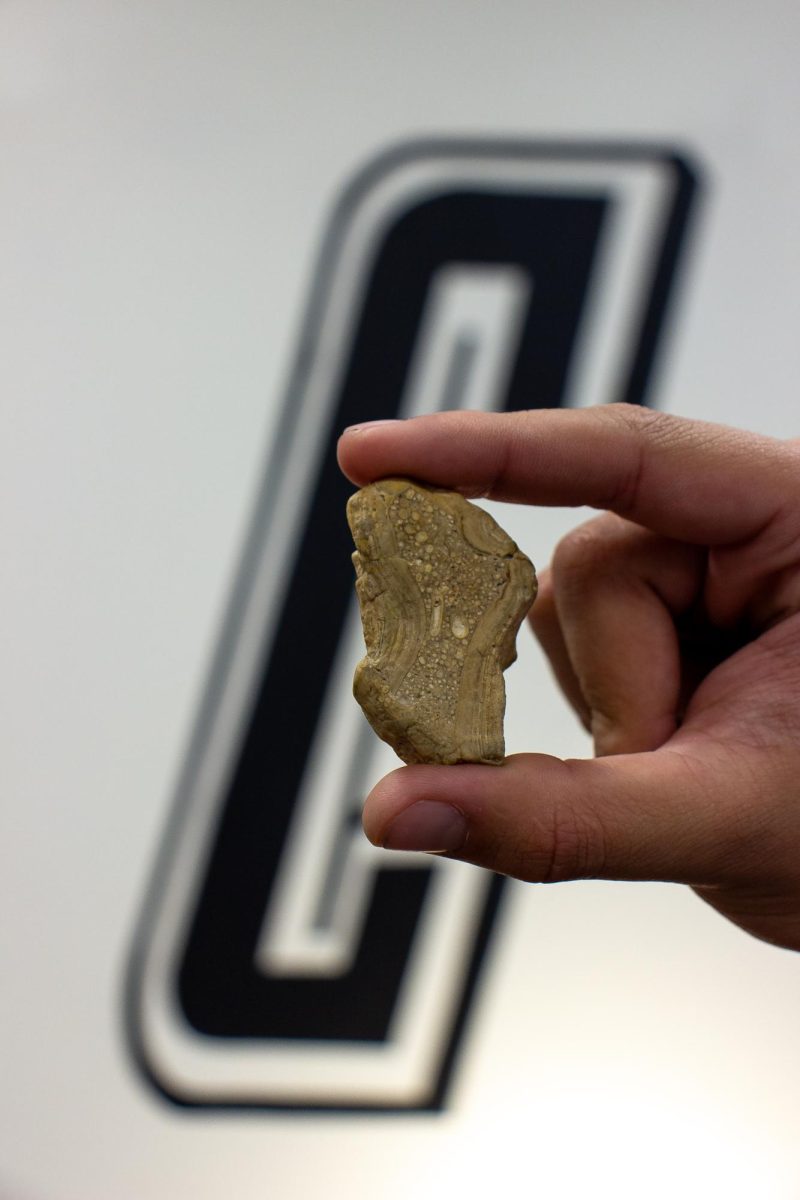
Marigold Nugent
Freshman pre-business administration major Luke Travis holds up the rock he found at Highline Lake State Park, which turned out to be an ancient piece of limestone.
When freshman pre-business administration major Luke Travis picked up a curious rock while exploring the natural areas around Highline Lake State Park, he did not expect it to spark debate among geologists, paleontologists and even the president of his university.
What looked like a coral fossil turned out to be something more complicated: a piece of limestone with fossil-like features that revealed some of Colorado’s deep marine history.
At first glance, the specimen’s concentric, circular patterns resemble those of skeletal coral colonies. Assistant professor of geosciences Dr. Wade L. Aubin is a geologist specializing in volcanic and sedimentary processes. He explained why the sample caused so much intrigue.
“Chemical analysis confirmed that the rock is limestone, which often forms in marine environments,” Aubin said. “The structures are consistent with ancient shallow-sea deposits. Whether ooids or corals, both point to a time when Colorado was completely underwater, long before the Rocky Mountains rose.”
Limestone belongs to the family of sedimentary rocks, and is most commonly composed of calcium carbonate. It often forms from compacted shells, coral, algae and other marine organisms. In the case of ooids, it can also form chemically.
Ooids are tiny, egg-shaped grains, usually less than 2 millimeters in diameter, that form in warm, shallow, wave-agitated seas. Over time, these grains become cemented together into a rock known as oolite, a type of limestone. Such stones are still forming today in locations such as the Bahamas and the Persian Gulf.
“This specimen isn’t a coral fossil but rather oolitic limestone, a rock formed from tiny ooids that collected and hardened on the sea floor,” Museums of Western Colorado paleontologist and CMU instructor Dr. Julia B. McHugh said. “It’s fossil-like in appearance, but what we’re seeing is chemistry and sedimentation at work, not preserved organisms.”
The distinction between fossil and oolite may seem small, but both interpretations point back to the same ancient truth: Colorado was once covered by the ocean. During the Cretaceous Period, about 100 million years ago, the Western Interior Seaway stretched from the Gulf of Mexico to the Arctic Ocean, submerging much of the state under warm, shallow water.
The ooids that formed in that sea were later buried by more sediment, compacted, and uplifted during the formation of the Rocky Mountains. Today, they sit thousands of feet above sea level as reminders of a vastly different landscape.
“This rock makes us pause and think about the passage of geologic time,” Aubin said. “The mountains we see today were once the ocean floor.”
When CMU’s President John Marshall had the chance to hold the rock himself, he connected it directly to CMU’s values.
“When I held the rock, my first thought was curiosity— what kind of process could leave behind such unusual patterns? That’s what makes geology so inspiring,” Marshall said. “If I were to tie it to one of CMU’s core values, it would be curiosity. Rocks like this make us ask questions about our world and its history.”
For some students, the discovery was more personal than academic. Freshman hospitality management major Michaela Van’t Land said the rock sparked her imagination even outside her field of study.
“I’ve never felt a connection to a rock before, but this one made me want to learn more about what Colorado looked like when it was under an ocean,” Van’t Land said. “I felt a connection to this rock like nothing I’ve ever felt before, and it was inspiring to be around Luke when he found it.”
Her words echo a broader theme— curiosity about the natural world is not limited to scientists or geologists. The Highline Lake specimen is more than just a piece of stone. It represents both biology and geology, showing how living processes and chemical can create patterns that endure for millions of years.
It also demonstrates that such a simple find can spark questions about the entire Earth’s history, inspire students across disciplines and highlight Colorado’s transformation from sea to mountains.
Similar oolitic limestone can be found across western Colorado, Utah and Wyoming, wherever ancient seabeds were preserved. But, this particular rock, picked up by a student on a casual day outdoors, has already become a small symbol of curiosity at CMU.
“That’s what makes geology so inspiring— you never know when you’re going to find something that makes you ask why,” Marshall said.